EX-99.1
Published on May 21, 2013

The PNC
Financial Services Group, Inc. Barclays London Conference
May 21, 2013
Exhibit 99.1 |
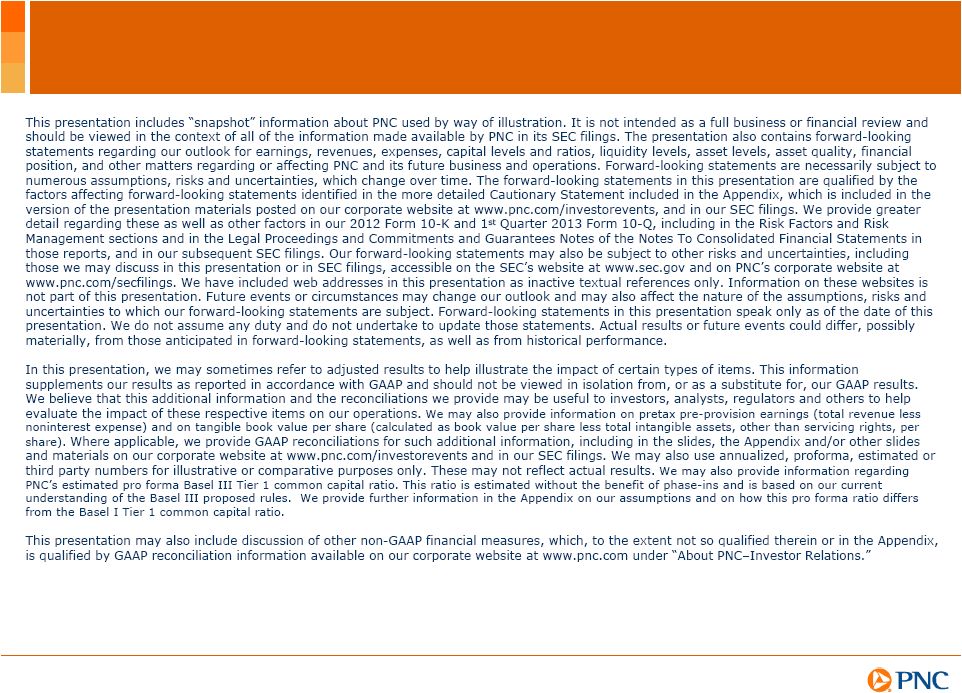
2
Cautionary Statement Regarding Forward-Looking
Information and Adjusted Information |
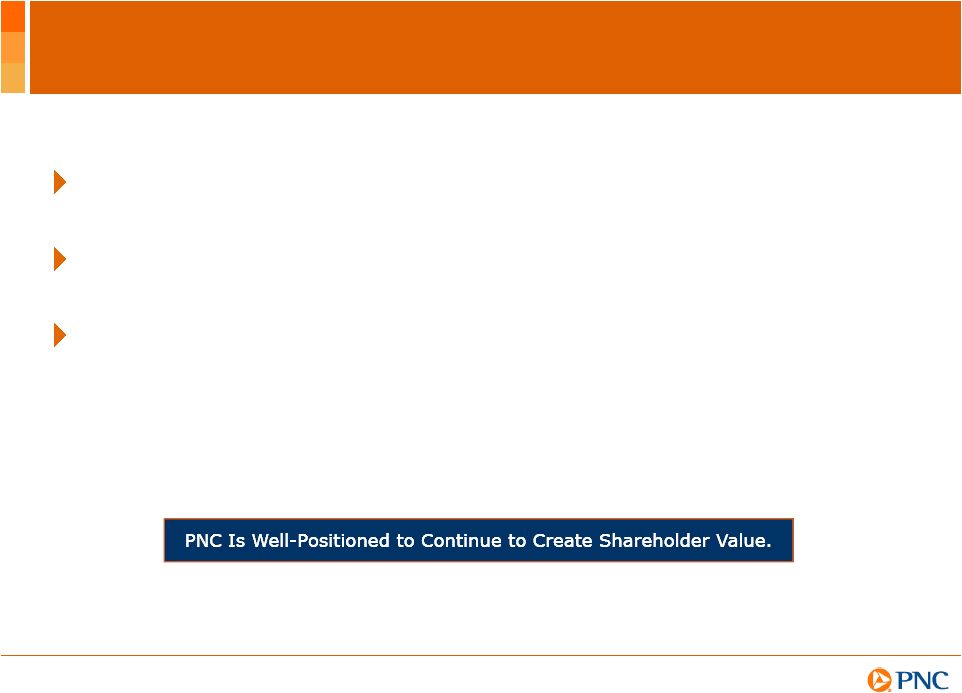
3
Todays Discussion
Overview of the PNC franchise
First quarter 2013 results
PNCs strategic priorities for growth |
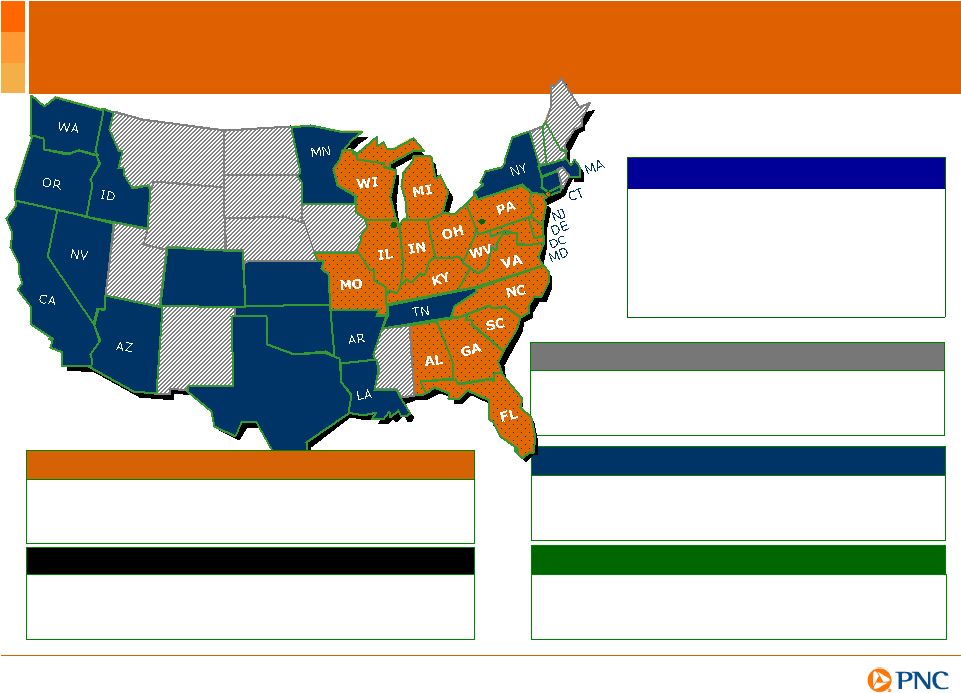
4
Corporate & Institutional
A leader in serving middle-market
customers and government entities
A top 10 U.S. bank-held wealth
manager
Asset Management
Residential Mortgage
A primary consumer product
National distribution capabilities
PNCs Powerful Franchise
(1) Rankings source: SNL DataSource; Holding companies (for assets) or Banks (for deposits,
branches and ATMs) headquartered in U.S. Assets rank excludes Morgan Stanley and
Goldman Sachs. CO
TX
KS
OK
BlackRock
A leader in investment management, risk
management and advisory services
worldwide
December 31, 2012
U.S. Rank
1
Deposits
$213B
7
th
Assets
$305B
9
th
Branches
2,881
5
th
ATMs
7,282
5
th
Footprint covering nearly half of the U.S.
population
Retail Banking |
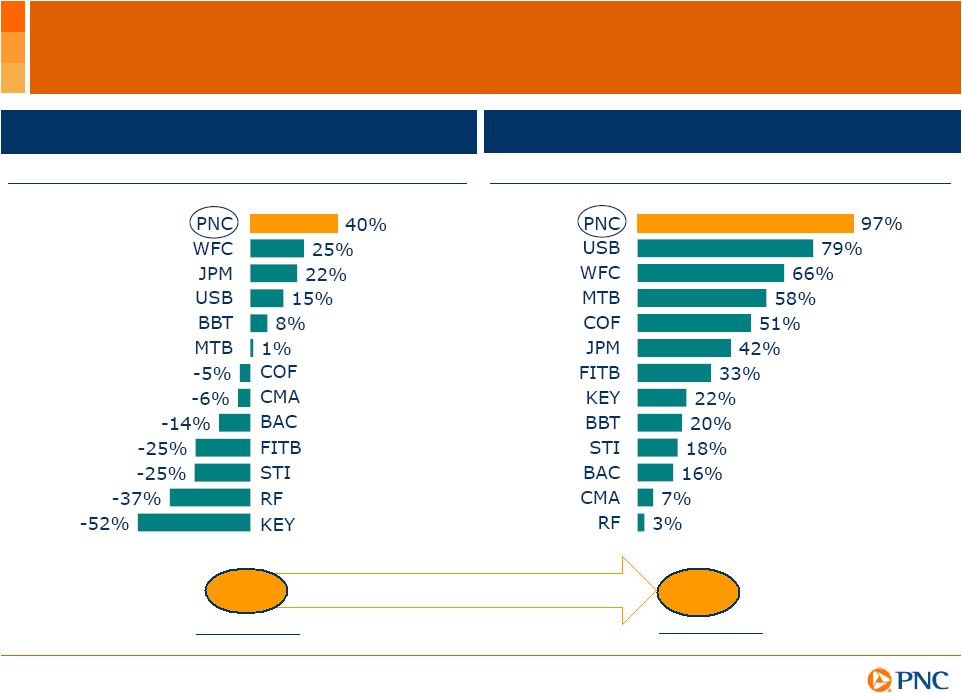
5
Value Creation Throughout the Economic Cycle
Peer Source: SNL DataSource. (1) Tangible book value (TBV) per share calculated as book value
per share less goodwill and certain other intangible assets. PNCs book value per
share was $44 and $67 at December 31, 2007 and December 31, 2012, respectively. Further
information is provided in the Appendix. % change in TBV/Share
1
12/31/2007 to 12/31/2009
% change in TBV/Share
1
12/31/2009 to 12/31/2012
Financial crisis
New normal
$49
PNCs TBV/Share
(1)
12/31/2007
12/31/2012
$18 |
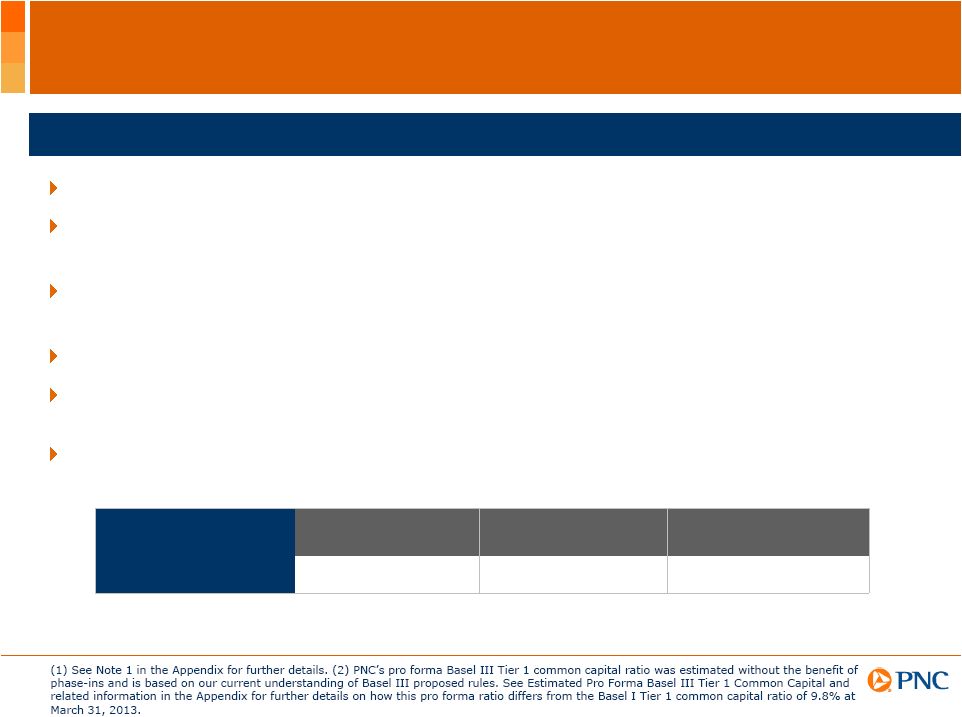
6
Strong First Quarter Results in a Challenging
Environment
Continued growth in customers and loans
Solid revenue and disciplined expense management drove higher earnings and
returns
Significant
linked
quarter
expense
reduction
$700
million
continuous
improvement target remains on track
Delivered strong returns
ROAA of 1.34%; ROACE of 10.68%
(1)
Strengthened capital levels
Pro forma Basel III Tier 1 common capital ratio
increased to 8.0%
(2)
Increased common dividend by 10% to $.44 per share effective with May
dividend
1Q13 achievements
1Q13 financial
summary
Net income
Diluted EPS from
net income
Return on
average assets
$1.0 billion
$1.76
1.34% |
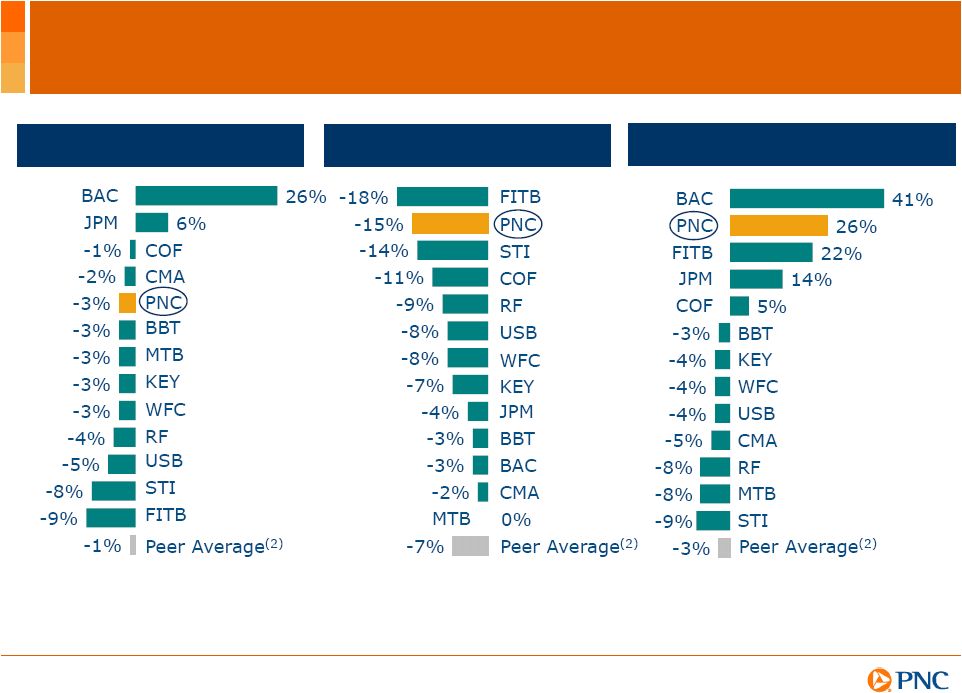
7
4Q12-1Q13
Expense growth
4Q12-1Q13
Revenue growth
Focused on Improving Earnings in 2013
4Q12-1Q13 Pretax
pre-provision earnings growth
(1)
(1)
See
Appendix
for
PNC
reconciliation.
See
Note
2
in
the
Appendix
for
further
details.
(2)
See
Note
3
in
the
Appendix
for
further
details.
Peer
Source: SNL Datasource. |
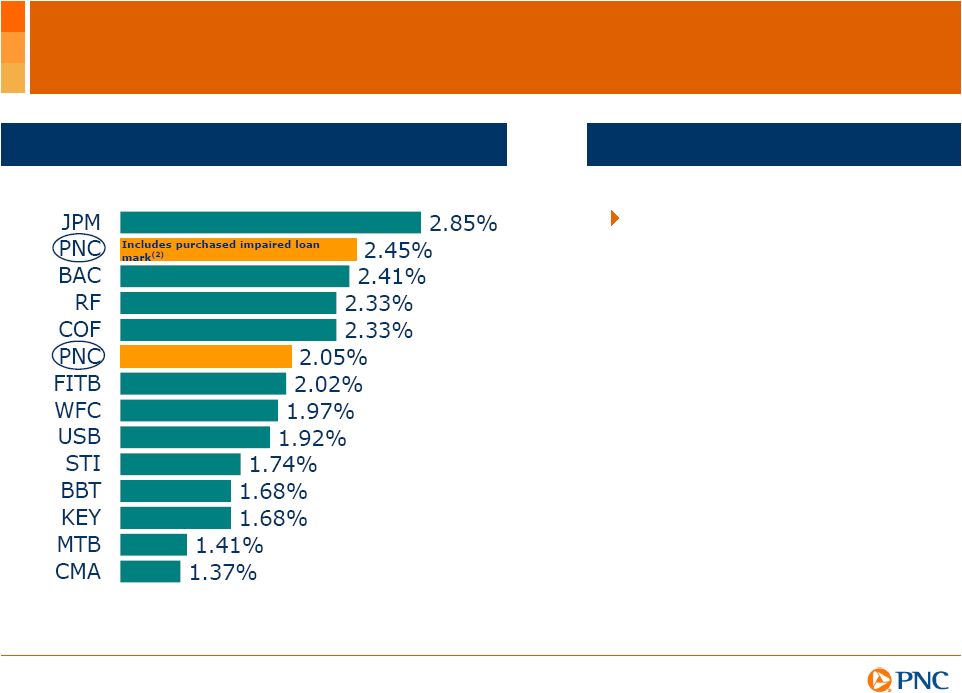
8
Effectively Managing Credit Risk
1Q13 loan loss reserves
1
to total loans
Reflects
company
data
for
1Q13
as
of
quarter-end.
Peer
source:
SNL
Datasource.
(1)
The
allowance
for
loan
and
lease
losses
includes impairment
reserves attributable to purchased impaired loans. (2) 1Q13 reserves/loans for PNC would have
been 2.45% if both reserves and loans had been adjusted to include the remaining marks
on purchased impaired loans. Further information is provided in the Appendix. Other peers have made
acquisitions and have marks on purchased impaired loans; however, no adjustments have been
made for those peers. Highlights
Strong underlying credit
trends continued to
improve |
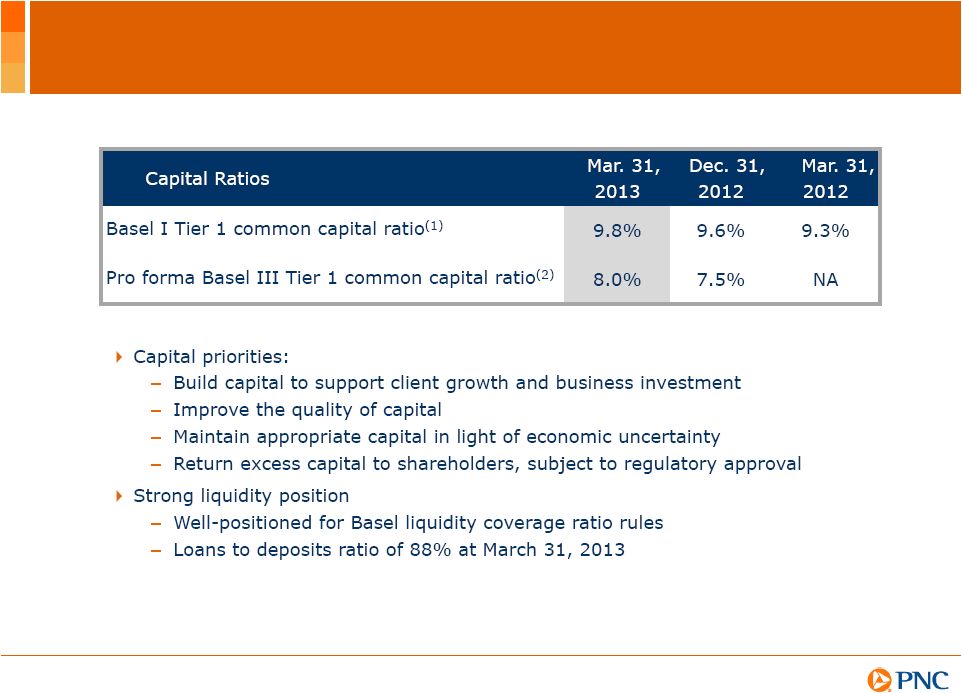
9
Strong Capital and Liquidity Position
(1)
See Note 4 in the Appendix for further details. (2) See Note 2 on Slide 6. Pro forma Basel III
Tier 1 common capital ratio estimate not provided in 1Q12.
|

10
Well-Positioned to Drive Growth
Develop and grow in newly acquired and underpenetrated
markets
Capture
more
investable
assets
build
on
strong
AMG
business model
Build a stronger Residential Mortgage Banking business
Redefine the Retail Banking business
Manage expenses
Strategic Priorities |
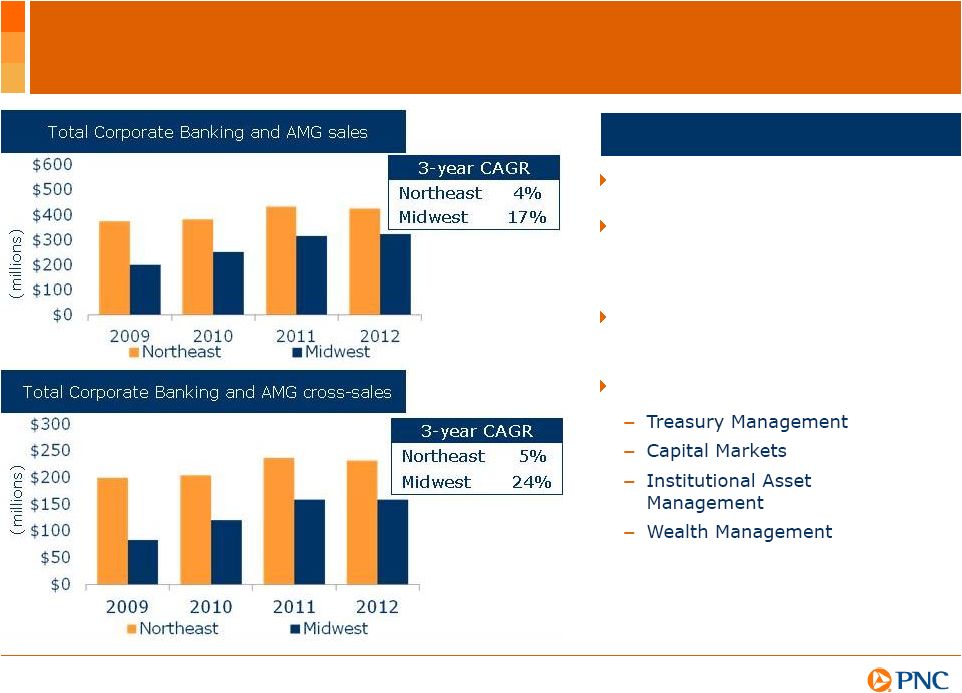
11
Corporate
Banking
is
a
business
within
Corporate
&
Institutional
Banking.
AMG
refers
to
Asset
Management
Group.
Highlights
Solid growth in the Northeast
Building momentum in Midwest
markets gives us confidence as
we enter the Southeast
Regional President model key to
success in all markets
Significant cross-sell opportunities
Deeper Penetration and Cross-sell in Underpenetrated
Markets |
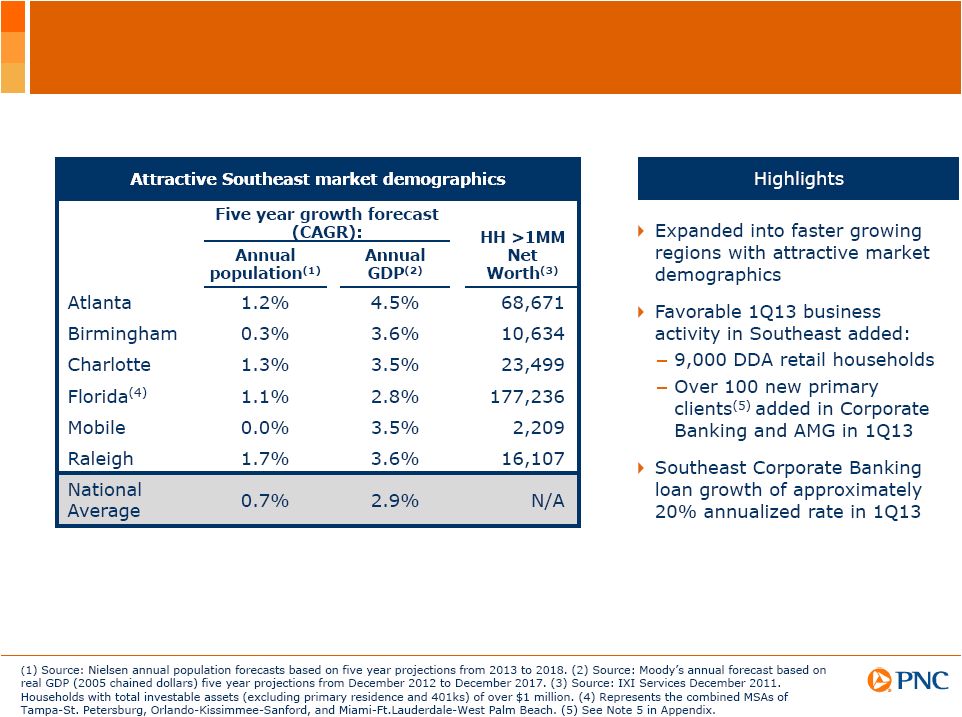
12
Newly Acquired Southeast Markets Provide Additional
Opportunities |
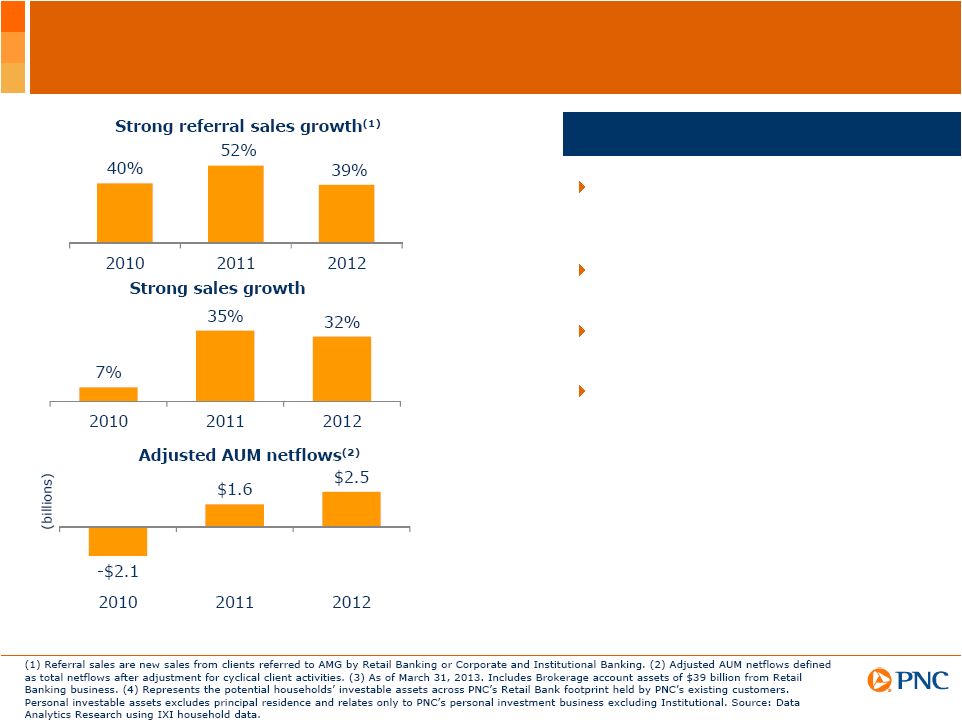
13
Investment & Retirement
Build on Strong AMG
Business Model
A top 10 U.S. bank-held wealth
manager -
$275 billion client assets
under administration
(3)
Approaching $1 billion in annual
AMG revenues
Referral sales contributed 36% of
total sales in 2012
Investment and Retirement
investable assets opportunity -
$1.9
trillion
(4)
(1)
Highlights |
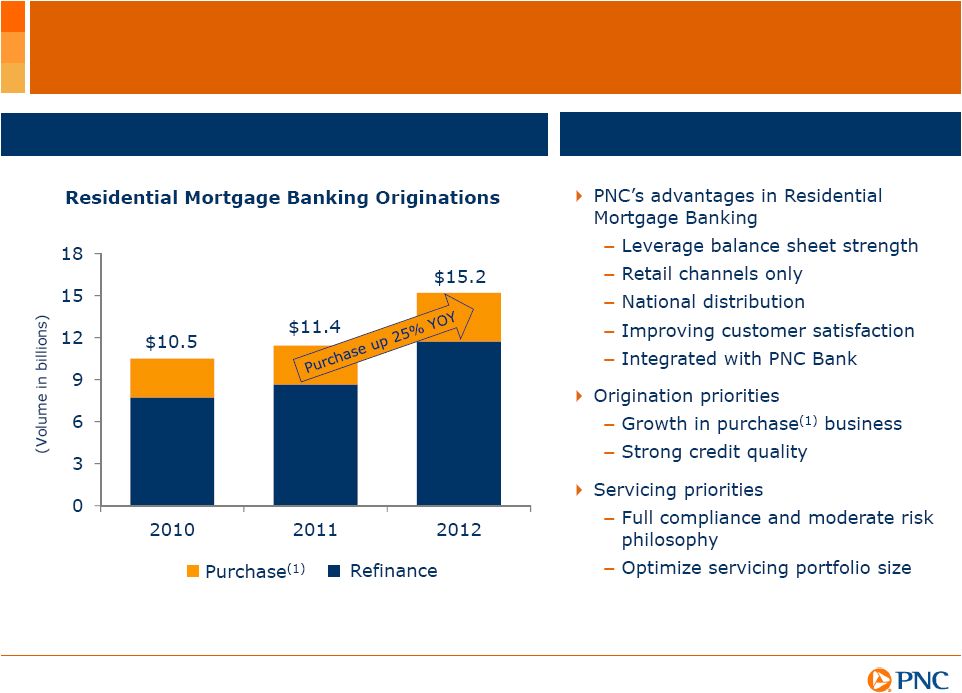
14
Building a Stronger Residential Mortgage Banking
Business
Growing the right way
Highlights
(1)
Purchase
is
defined
as
a
mortgage
with
a
borrower
as
part
of
a
residential
real
estate
purchase
transaction. |

15
(
1) Percentages reflect the proportion of PNC customers considered to be traditional branch,
primarily virtual or multi-channel customers based upon channels utilized for
transactions. See Note 6 in Appendix for further details. (2) Monthly transactions reflect
the monthly average for transactions conducted from October 2010-November 2011. Potential
in chart represents potential for ATM/Mobile channel percentage if transactions were to
migrate from Teller to ATM/Mobile channel. Serving Customers Tomorrow -
Redefining the Retail
Branch Network |

16
Managing Expenses -
2013 Expense Opportunities
(1)
Lower service
delivery costs
Branch
consolidation
Staffing and
back office
efficiencies
Enhance
staffing
model
Review loan
origination
process
Online
investment
platform
and
centralized
services
Lower
mortgage
foreclosure
compliance
costs
Staffing
efficiencies
Continued
focus on
consulting
expense
reductions
(1) Refer to Cautionary Statement in the Appendix, including economic and other assumptions.
Does not take into account the impact of potential legal and regulatory contingencies.
Continuous improvement $700 million goal
achieved approximately
$500 million of annualized savings in 1Q13
Retail
Banking
Corporate &
Institutional
Banking
Asset
Management
Group
Residential
Mortgage
Banking
Shared
Services |

17
Key Take-Aways
PNC has the scale and business model to win
Continued expense discipline
strong commitment
to continuous improvement savings
Positioned in 2013 to deliver improved earnings
Strategic growth priorities to create long-term
value
Strong capital position
greater flexibility for
capital returns in 2014 |

18
Cautionary Statement Regarding Forward-Looking
Information
This presentation includes snapshot
information about PNC used by way of illustration and is not intended as a full business or
financial review. It should not be viewed in isolation but rather in the context
of all of the information made available by PNC in its SEC filings. We also make
statements in this presentation, and we may from time to time make other statements, regarding our outlook for earnings,
revenues, expenses, capital levels and ratios, liquidity levels,
asset levels, asset quality, financial position, and other matters regarding or
affecting PNC and its future business and operations that are forward-looking statements
within the meaning of the Private Securities Litigation Reform Act.
Forward-looking statements are typically identified by words such as believe,
plan,
expect,
anticipate,
see,
look,
intend,
outlook,
project,
forecast,
estimate,
goal,
will,
should
and other similar words and expressions. Forward-
looking statements are subject to numerous assumptions, risks and uncertainties, which change
over time. Forward-looking statements speak only as of the date made. We do
not assume any duty and do not undertake to update forward-looking
statements. Actual results or future events could differ, possibly materially, from
those anticipated in forward-looking statements, as well as from historical
performance. Our forward-looking statements are subject to the following principal
risks and uncertainties. Our businesses, financial results and balance sheet
values are affected by business and economic conditions, including the following:
Changes in interest rates and valuations in debt, equity and other financial markets.
Disruptions in the liquidity and other functioning of U.S. and global financial
markets. The impact on financial markets and the economy of any changes in the credit
ratings of U.S. Treasury obligations and other U.S. government-backed
debt,
as
well
as
issues
surrounding
the
level
of
U.S.
and
European
government
debt
and
concerns
regarding
the creditworthiness of certain sovereign governments, supranationals and financial
institutions in Europe. Actions by Federal Reserve, U.S. Treasury and other government
agencies, including those that impact money supply and market interest rates.
Changes
in
customers,
suppliers
and
other
counterparties
performance
and
creditworthiness.
Slowing or failure of the current moderate economic expansion.
Continued effects of aftermath of recessionary conditions and uneven spread of positive
impacts of recovery on the economy and our counterparties, including adverse impacts on
levels of unemployment, loan utilization rates, delinquencies, defaults and
counterparty ability to meet credit and other obligations.
Changes in customer preferences and behavior, whether due to changing business and economic
conditions, legislative and regulatory initiatives, or other factors.
Our forward-looking financial statements are subject to the risk that economic and
financial market conditions will be substantially different than we are currently
expecting. These statements are based on our current view that the moderate economic expansion will persist and
interest rates will remain very low in 2013, despite drags from Federal fiscal restraint and a
European recession. These forward-looking statements also do not, unless
otherwise indicated, take into account the impact of potential legal and regulatory contingencies.
Appendix |

19
Cautionary Statement Regarding Forward-Looking
Information (continued)
PNCs ability to take certain capital actions, including paying dividends and any plans
to increase common stock dividends, repurchase common stock under current or future
programs, or issue or redeem preferred stock or other regulatory capital instruments, is subject to
the review of such proposed actions by the Federal Reserve as part of PNCs comprehensive
capital plan for the applicable period in connection
with
the
regulators
Comprehensive
Capital
Analysis
and
Review
(CCAR)
process
and
to
the
acceptance
of
such
capital
plan
and
non-objection to such capital actions by the Federal Reserve.
PNCs regulatory capital ratios in the future will depend on, among other things,
the companys financial performance, the scope and terms of final capital
regulations then in effect (particularly those implementing the Basel Capital Accords), and management actions affecting the
composition
of
PNCs
balance
sheet.
In
addition,
PNCs
ability
to
determine,
evaluate
and
forecast
regulatory
capital
ratios,
and
to
take
actions (such as capital distributions) based on actual or forecasted capital ratios, will be
dependent on the ongoing development, validation and regulatory approval of related
models. Legal
and
regulatory
developments
could
have
an
impact
on
our
ability
to
operate
our
businesses,
financial
condition,
results
of
operations,
competitive
position,
reputation,
or
pursuit
of
attractive
acquisition
opportunities.
Reputational
impacts
could
affect
matters
such
as
business generation and retention, liquidity, funding, and ability to attract and retain
management. These developments could include: Changes resulting from legislative
and regulatory reforms, including major reform of the regulatory oversight structure of the
financial services industry and changes to laws and regulations involving tax, pension,
bankruptcy, consumer protection, and other industry aspects, and changes in accounting
policies and principles. We will be impacted by extensive reforms provided for in the
Dodd-Frank Wall Street Reform and Consumer Protection Act (the Dodd-Frank
Act) and otherwise growing out of the recent financial crisis, the precise
nature, extent and timing of which, and their impact on us, remains uncertain. Changes
to regulations governing bank capital and liquidity standards, including due to the Dodd-Frank Act and to Basel-related
initiatives.
Unfavorable resolution of legal proceedings or other claims and regulatory and other
governmental investigations or other inquiries.
In
addition
to
matters
relating
to
PNCs
business
and
activities,
such
matters
may
include
proceedings,
claims,
investigations, or inquiries relating to pre-acquisition business and activities of
acquired companies, such as National City. These matters
may
result
in
monetary
judgments
or
settlements
or
other
remedies,
including
fines,
penalties,
restitution
or
alterations
in
our business practices, and in additional expenses and collateral costs, and may cause
reputational harm to PNC. Results of the regulatory examination and supervision
process, including our failure to satisfy requirements of agreements with governmental
agencies. Impact
on
business
and
operating
results
of
any
costs
associated
with
obtaining
rights
in
intellectual
property
claimed
by
others
and of adequacy of our intellectual property protection in general.
Appendix |

20
Cautionary Statement Regarding Forward-Looking
Information (continued)
Business and operating results are affected by our ability to identify and effectively
manage risks inherent in our businesses, including, where
appropriate,
through
effective
use
of
third-party
insurance,
derivatives,
and
capital
management
techniques,
and
to
meet
evolving
regulatory capital standards. In particular, our results currently depend on our ability
to manage elevated levels of impaired assets. Business
and
operating
results
also
include
impacts
relating
to
our
equity
interest
in
BlackRock,
Inc.
and
rely
to
a
significant
extent
on
information provided to us by BlackRock. Risks and uncertainties that could affect
BlackRock are discussed in more detail by BlackRock in its SEC filings.
We grow our business in part by acquiring from time to time other financial services
companies, financial services assets and related deposits and other liabilities.
Acquisition risks and uncertainties include those presented by the nature of the business acquired, including
in some cases those associated with our entry into new businesses or new geographic or other
markets and risks resulting from our inexperience in those new areas, as well as risks
and uncertainties related to the acquisition transactions themselves, regulatory issues, and
the integration of the acquired businesses into PNC after closing.
Competition can have an impact on customer acquisition, growth and retention and on
credit spreads and product pricing, which can affect market share, deposits and
revenues. Industry restructuring in the current environment could also impact our business and financial
performance
through
changes
in
counterparty
creditworthiness
and
performance
and
in
the
competitive
and
regulatory
landscape.
Our
ability to anticipate and respond to technological changes can also impact our ability to
respond to customer needs and meet competitive demands.
Business and operating results can also be affected by widespread natural and other
disasters, dislocations, terrorist activities or international hostilities through
impacts on the economy and financial markets generally or on us or our counterparties specifically.
We provide greater detail regarding these as well as other factors in our 2012 Form 10-K
and 1st Quarter 2013 Form 10-Q, including in the Risk Factors and Risk Management
sections and the Legal Proceedings and Commitments and Guarantees Notes of the Notes To
Consolidated Financial Statements in those reports, and in our subsequent SEC filings.
Our forward-looking statements may also be subject to
other
risks
and
uncertainties,
including
those
we
may
discuss
elsewhere
in
this
presentation
or
in
SEC
filings,
accessible
on
the
SECs
website at www.sec.gov and on our corporate website at www.pnc.com/secfilings. We have
included these web addresses as inactive textual references only. Information on
these websites is not part of this document. Any annualized, proforma, estimated, third
party or consensus numbers in this presentation are used for illustrative or comparative
purposes
only
and
may
not
reflect
actual
results.
Any
consensus
earnings
estimates
are
calculated
based
on
the
earnings
projections
made
by
analysts
who
cover
that
company.
The
analysts
opinions,
estimates
or
forecasts
(and
therefore
the
consensus
earnings
estimates)
are
theirs alone, are not those of PNC or its management, and may not reflect PNCs or other
companys actual or anticipated results. Appendix |

21
Notes
Appendix
Explanatory Notes
(1) ROAA is Return on Average Assets and ROACE is Return on Average Common Equity.
(6) Transactions refer to service transactions which include deposits, withdrawals and
payments. Traditional branch customer is a customer who conducts greater than 80% of
monthly transactions in a branch. Primarily Virtual customer is a customer who conducts
the majority of monthly transactions at non-branch channels (i.e., ATM, Online, Call Center, Mobile). Multi-channel
customer is a customer who uses all the channels including branch but is not dominant in any.
(2) Pretax pre-provision earnings is defined as total revenue less noninterest
expense. We believe that pretax pre-provision earnings, a non-GAAP measure, is
a useful tool to help evaluate the ability to provide for credit costs through operations.
(5) A Corporate Banking primary client is defined as a corporate banking relationship with
annual revenue generation of $50,000 or more or, within corporate banking, a commercial
banking client relationship with annual revenue generation of $10,000 or more. An Asset
Management Group primary client is defined as a client relationship with annual revenue generation of $10,000 or more.
(3) Peer Average refers to average of the peers listed in the table. Peer information
source: SNL Datasource. (4) Basel I Tier 1 common capital
ratio is period-end Tier 1 common capital divided by period-end Basel I risk-weighted assets. |

22
Estimated Pro Forma Basel III Tier 1 Common Capital
Appendix
PNC's pro forma Basel III Tier 1 common capital ratio was estimated without the benefit of
phase-ins and is based on our current understanding of Basel III proposed
rules. PNC utilizes this estimate to assess its Basel III capital position, including
comparison to similar estimates made by other financial institutions. Tier 1 common capital as
defined under the proposed Basel III rules differs materially from Basel I. Under Basel
III, unconsolidated investments in financial institutions, mortgage servicing rights
and deferred tax assets must be deducted from capital to the extent that they individually exceed 10%, or in
the aggregate exceed 15%, of the institutions adjusted Tier I common capital.
Also, Basel I regulatory capital excludes certain other comprehensive income related to
both available for sale securities and pension and other postretirement plans, whereas
under Basel III these items are a component of capital. Basel III risk-weighted assets were estimated under Basel
II (including the modifications to the advanced approaches proposed under Basel III) and
application of Basel II.5, and reflect credit, market and operational risk. This
Basel III capital estimate is likely to be impacted by the finalization of the Basel III
rules, further regulatory clarity relating to the capital rules, and the ongoing evolution,
validation and regulatory approval of PNC's models integral to the calculation of Basel
II risk-weighted assets. We
provide
information
below
regarding
PNCs
pro
forma
fully
phased-in
Basel
III
Tier
1
common
capital
ratio
and
how
it
differs
from
the
Basel
I
Tier
1
common
capital
ratio
as
we
expect
the
Basel
III
ratio
to
replace
the
current
Basel
I
ratio
for
this
regulatory
metric
when
the
applicable
rules
are
finalized
and fully implemented and PNC exits the parallel run qualification phase under Basel II.
Estimated Pro forma Basel III Tier 1 Common Capital Ratio
Dollars in millions
March 31, 2013
December 31, 2012
Basel I Tier 1 common capital
$25,680
$24,951
Less regulatory capital adjustments:
Basel III quantitative limits
(2,076)
(2,330)
Accumulated other comprehensive income (a)
289
276
All other adjustments
(367)
(396)
Estimated Basel III Tier 1 common capital
$23,526
$22,501
Estimated Basel III risk-weighted assets
293,810
301,006
Pro forma Basel III Tier 1 common capital ratio
8.0%
7.5%
Basel I Tier 1 Common Capital Ratio
Dollars in millions
March 31,2013
December 31, 2012
Basel I Tier 1 common capital
$25,680
$24,951
Basel I risk-weighted assets
261,491
260,847
Basel I Tier 1 common capital ratio
9.8%
9.6%
(a) Represents net adjustments related to accumulated other comprehensive
income for available for sale securities and pension and other postretirement
benefit plans. |
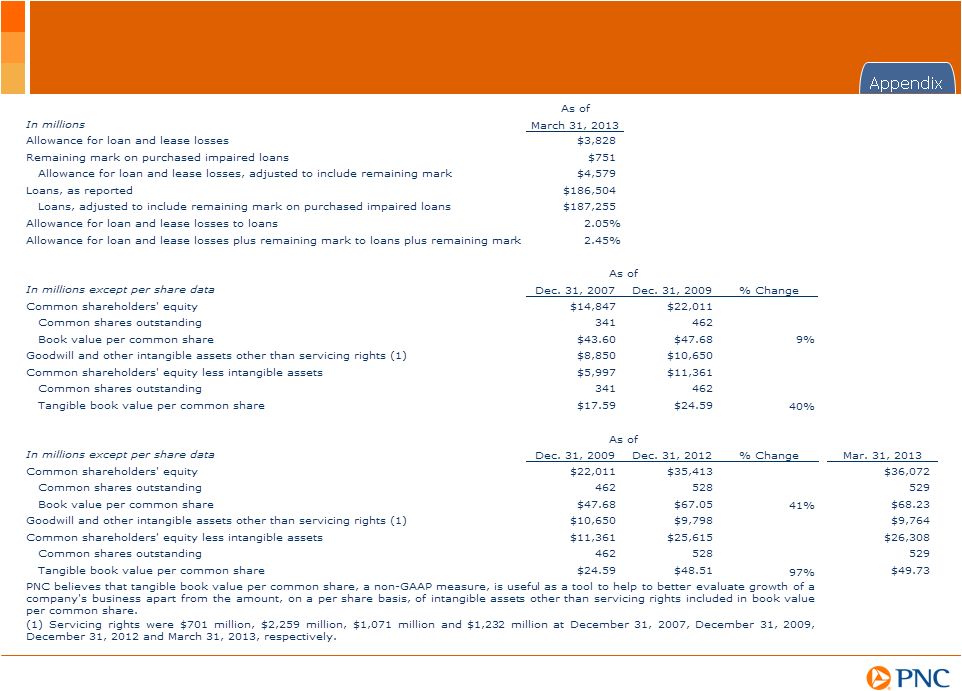
Non-GAAP
to GAAP Reconcilement 23 |

24
Non-GAAP to GAAP Reconcilement
Appendix
In millions
Mar. 31, 2013
Dec. 31, 2012
% Change
Net interest income
$2,389
$2,424
Noninterest income
$1,566
$1,645
Total revenue
$3,955
$4,069
Noninterest expense
($2,395)
($2,829)
Pretax pre-provision earnings
$1,560
$1,240
26%
Net income
$1,004
$719
40%
See Note 2 on Slide 22.
In millions for full year 2012
Total noninterest expense, as reported
$10,582
Integration costs
(267)
Trust preferred securities redemption-related charges
(295)
Noninterest expense, core
$10,020
In
full
year
2013,
PNC
does
not
expect
to
incur
integration
costs
and
anticipates
the
charges
for
noncash
charges
related to redemption of trust preferred securities to be approximately $60 million or
less. Quarter Ended |

25
Peer Group of Banks
Appendix
The PNC Financial Services Group, Inc.
PNC
BB&T Corporation
BBT
Bank of America Corporation
BAC
Capital One Financial, Inc.
COF
Comerica Inc.
CMA
Fifth Third Bancorp
FITB
JPMorgan Chase
JPM
KeyCorp
KEY
M&T Bank
MTB
Regions Financial Corporation
RF
SunTrust Banks, Inc.
STI
U.S. Bancorp
USB
Wells Fargo & Co.
WFC |